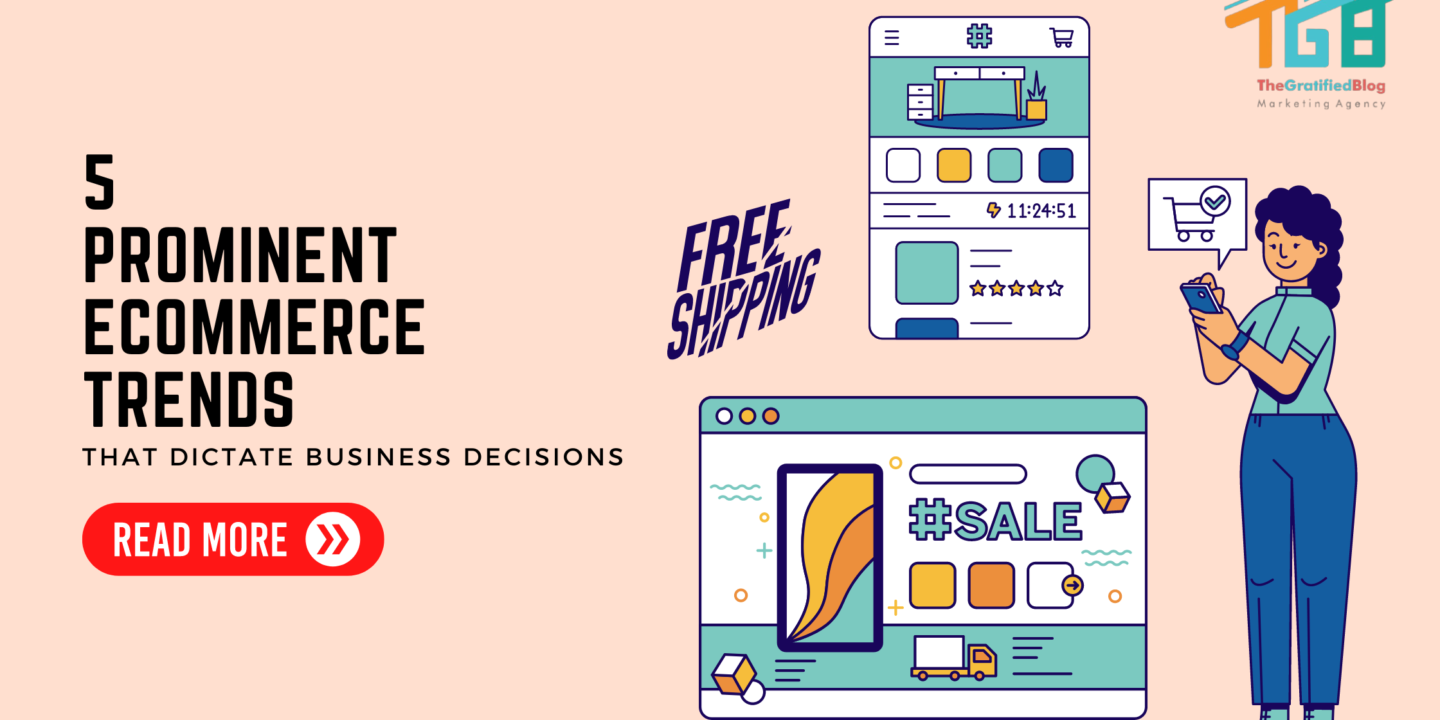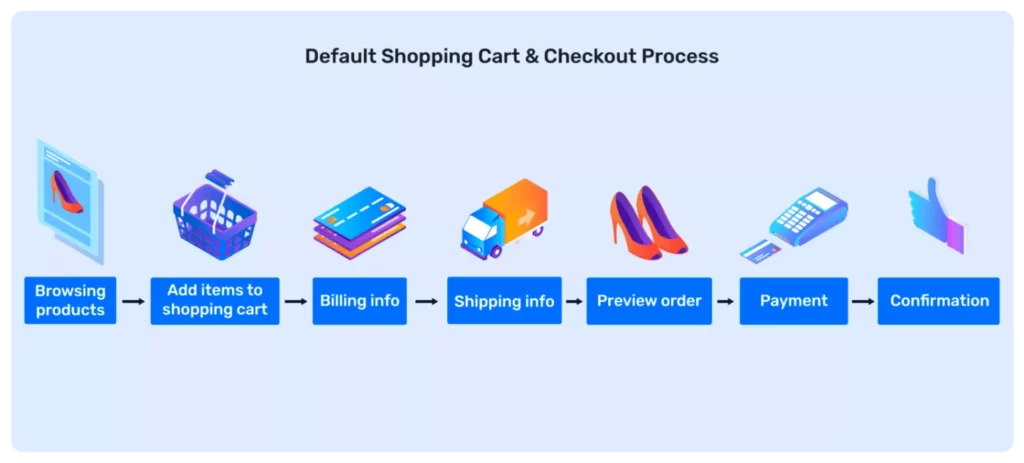
Failure to adapt to market changes can result in detrimental outcomes for online businesses. Staying updated with new ecommerce trends is imperative.
In today’s competitive landscape, making swift decisions is crucial, especially for emerging businesses striving to carve their place within their niches.
Therefore, it is essential to acknowledge the significance of adapting to market changes, following new e-commerce trends, and making timely decisions to maintain competitiveness in the online business realm.
Some things are stable in eCommerce, whereas others come and go just like that. You must identify which innovations and ecommerce trends are relevant and whether you need to implement them for your business.
The purpose of this article is to preview some of the most prominent ecommerce trends shaping the direction in which eCommerce is going.
The Top 8 Latest E-commerce Trends To Stay Ahead Of The Game
- Freedom To Choose
If your business embraces the concept, empower shoppers with the freedom to make choices. This goes beyond merely creating a façade of control for customers.
Offering a diverse range of options in itself holds its advantages. Allow me to illustrate this with two examples.
Printify is a highly sought-after platform renowned for its ability to simplify the process of designing custom t-shirts.
By leveraging Printify’s services, individuals can effortlessly transform their imaginative concepts into actual garments.
The platform empowers users to personalize their t-shirts with distinctive logos, captivating artwork, and impactful slogans, enabling them to convey their brand identity or personal flair effectively.
With Printify, the journey from idea to reality becomes seamless, empowering creativity and enabling individuals to showcase their unique style through customized t-shirts.
One of Printify’s key advantages is its huge selection of t-shirt designs, colors, and sizes, allowing you to make unique t-shirt designs that stand out.
Whether you’re looking to create a bold statement with a graphic tee or keep it simple with a classic white shirt, Printify has got you covered.
Example 2: Nike has embraced this philosophy by offering extensive product customization options.
By allowing customers to personalize everything from the color scheme to the design elements, Nike empowers individuals to create unique, personalized products that resonate with their preferences.
This freedom enhances the shopping experience and fosters a more profound sense of ownership and connection between the brand and its customers.
- Voice Shopping
Voice shopping swiftly became a reality thanks to the emergence of voice-activated digital assistants like Alexa.
The concept is straightforward: Users can simply vocalize their purchase requests into a microphone rather than manually inputting relevant keywords on a device’s keyboard.
This streamlined approach eliminates the need for typing and allows for a more natural and convenient shopping experience.
Consumers can communicate their desired products with a few words, making the process efficient and user-friendly.
Voice-controlled technology has revolutionized how we shop, offering a hands-free alternative that enhances convenience in the digital age.
Voice shopping offers unique opportunities for disabled individuals, granting them greater accessibility.
With an increasing number of stores embracing voice shopping, ordering goods and services has simplified significantly.
Nevertheless, it is crucial to recognize the difficulties linked with executing this technology. Optimizing an online store to accommodate voice commands demands substantial effort and resources, posing a significant hurdle for businesses.
The concept, though newer than eCommerce overall, will inevitably gain prominence with increasing ease and affordability of its utilization.
Its significance will grow as it evolves in the digital landscape, surpassing traditional eCommerce. The undeniable trend is poised to become a prominent force, shaping the future of online business.

Source: nitropack.io
- Quick Checkout Process
Some stores continue complicating the checkout process, adding unnecessary steps for shoppers.
They burden customers with mundane tasks and extra information fields, distracting them from completing their purchases.
However, it is essential to remember that not all stores follow this approach, as some recognize the importance of a streamlined and efficient checkout experience.
These stores prioritize customer satisfaction by eliminating unnecessary complexities and facilitating a smoother purchasing process.
Refraining from requesting a registered shopping account is valuable, considering the potential benefits.
Doing otherwise would likely manifest as an increase in abandoned shopping carts. Opting for a guest shopping experience becomes a viable alternative, particularly for individuals seeking a one-time transaction.
You enhance their convenience and efficiency by providing customers with a streamlined method to finalize their purchase and proceed.

- Virtual Reality
The purpose of virtual reality in eCommerce trends is primarily to give shoppers the option to try certain goods and services in person. At least as far as virtual reality can offer that.
The popularity of eCommerce has surged; however, when it comes to certain items, online shopping raises doubts for some individuals.
They ponder their choices, yearning for a better alternative. By utilizing virtual reality (VR) technology, individuals can visually inspect the desired furniture, transcending mere pictures or videos.
Such an immersive experience would simplify decision-making before investing their hard-earned money.
Voice shopping, which allows users to make purchases using voice commands, has gained popularity, but integrating virtual reality (VR) into online stores is still a distant prospect. Significant companies are facing challenges in implementing VR effectively.
Despite these obstacles, the future of VR looks promising, with optimistic projections suggesting increased adoption and utilization in the coming years.
With the progress of technology, we anticipate a more significant presence of VR in online shopping experiences.

Source: maropost.com
- Augmented Reality
Augmented Reality (AR) integrates digital content into the real world, providing users an immersive and interactive experience.
In contrast to Virtual Reality (VR), which constructs a fully simulated environment, AR enriches the physical world by overlaying digital elements onto the user’s perspective.
These digital elements can consist of images, videos, or 3D models. By integrating these digital elements into the user’s view, AR enhances the surroundings and provides an immersive encounter.
It offers a unique blend of the natural and virtual realms, allowing users to engage with both simultaneously.
This technology introduces additional information and entertainment to the user’s perception of reality.
AR technology combines real-world elements with digital content through different techniques.
It relies on cameras or sensors to capture the physical environment and accurately track the user’s movements and position.
These captured data are then processed and merged with digital content in real-time, aligning with the user’s point of view.
The integration seamlessly renders and displays the combined content, allowing users to perceive the digital objects or information as if they were part of the real world.
In summary, AR technology utilizes cameras/sensors to capture and track the user’s surroundings, process the data, merge it with digital content, and present the combined result in real-time, creating an immersive and interactive experience.
- Artificial Intelligence
AI technology, such as chatbots, continues gaining popularity each year. Particularly in the field of customer support, chatbots are gradually replacing human representatives.
These automated systems provide prompt and accurate responses, available round the clock, making them an advantageous choice for businesses seeking long-term investments in valuable innovations.
The convenience and reliability of AI-driven customer support contribute to its growing adoption.
Artificial intelligence offers numerous advantages beyond chatbots, particularly for individuals dealing with large volumes of data.
Researching and processing extensive information can be arduous and monotonous for humans.
However, with the assistance of AI, this becomes a more manageable endeavor. By delegating data processing to AI systems, individuals can alleviate the burden of tedious tasks and focus on higher-level analysis and decision-making.
Efficiency and productivity in managing intricate datasets are enhanced, saving time.
Artificial Intelligence (AI) is highly valuable and is expected to continue growing as a significant trend for the foreseeable future.
Given its significance, technology professionals should consider taking AI courses to expand their skill sets and enhance their chances of securing employment.
By acquiring knowledge and expertise in AI, professionals can position themselves as desirable candidates in the job market, aligning with the increasing demand for AI-related skills.
Taking proactive steps to improve AI proficiency can significantly enhance career prospects in this evolving field.

Source: dresma.ai
- Live Streaming Commerce
Live streaming commerce is a prominent phenomenon in the eCommerce trends, leveraging the potency of live video streaming alongside online shopping.
This innovative approach enables businesses to interact with their customers actively in real time, fostering customer engagement and bolstering sales.
Several companies have enthusiastically adopted this trend, exemplifying its effectiveness in driving business growth.
These forward-thinking organizations have recognized the value of live-streaming commerce as a dynamic and effective means of connecting with customers and generating revenue.
Here are a few examples of companies that have embraced this trend:
- Walmart + TikTok: Walmart partnered with TikTok, a popular social media platform, to launch a live shopping experience. During these live streams, TikTok users can purchase products featured in the videos directly within the app, creating a seamless shopping experience.
- Amazon Live: Amazon Live is a platform that enables sellers to stream live videos showcasing their products. Customers can engage with the hosts and complete purchases instantly. Amazon Live has gained popularity as a place for brands to demonstrate their products and engage with shoppers in real-time.
- Facebook + Live Shopping Fridays: Facebook introduced Live Shopping Fridays, a program encouraging businesses to host live shopping events. These events allow businesses to present their products through live videos and engage with viewers through comments and questions. Customers can make purchases directly from the stream.
These examples highlight how live-streaming commerce is being adopted by major eCommerce players, leveraging the popularity and engagement of social media platforms to enhance the shopping experience and drive sales.
The real-time interaction and convenience of purchasing during the live streams make this trend appealing to businesses and customers.

Source: springwise
- M-commerce (Mobile Commerce)
Mobile commerce, commonly known as m-commerce, is the process of conducting commercial transactions involving Exchanging and Engaging in the commerce of goods and Leveraging mobile devices, like smartphones and tablets, to provide goods and services.
This trend has gained immense traction in eCommerce due to the rising popularity and widespread availability of mobile devices.
The proliferation of mobile apps and optimized websites has revolutionized how consumers shop, providing them the convenience of making purchases while on the move.
This has significantly increased mobile transactions, as customers can now easily browse and buy products or services through their mobile devices.
Retailers have recognized the potential of m-commerce and have adopted various mobile-specific features to enhance the mobile shopping experience.
Push notifications alert customers about special offers, discounts, and new arrivals. Location-based marketing enables retailers to send targeted promotions based on the customer’s location.
Mobile wallets have also been integrated, allowing users to make secure and swift payments using their mobile devices.
Overall, m-commerce has transformed the retail landscape by enabling seamless and efficient transactions through mobile devices, contributing to the growth of the eCommerce industry.

Source : shopify.com
FAQS
Is eCommerce down in 2023?
The answer to whether eCommerce marketing will be down in 2023 is no. According to various sources, eCommerce sales are expected to grow in 2023, although the growth rate may be slower than in previous years. Global eCommerce growth is expected to be 8.9% in 2023, bringing global eCommerce sales to $5.9 trillion.
Forbes reports that eCommerce sales are expected to grow 10.4% in 2023, and 20.8% of retail purchases will occur online in 2023. However, global eCommerce growth rates are now in the single digits, and total retail sales growth worldwide will muddle through at just under 4% in 2023.
Conclusion
All in all, there are multiple notable trends as far as ecommerce trends go. Adapting to new and current innovations is necessary whether you are an already established business or still in its early stages. It can be tricky and demanding resource-wise, but if a long-term investment is a good decision for a company, taking that step is a given.








No Comments